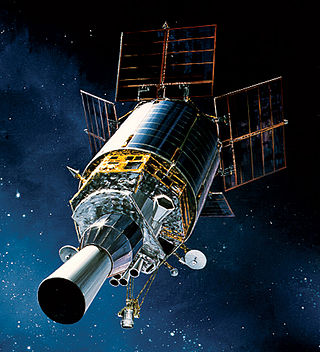
A field-programmable gate array (FPGA) is a type of integrated circuit that can be programmed or reprogrammed after manufacturing. It consists of an array of programmable logic blocks and interconnects that can be configured to perform various digital functions. FPGAs are commonly used in applications where flexibility, speed, and parallel processing capabilities are required, such as in telecommunications, automotive, aerospace, and industrial sectors.
The PowerPC 7xx is a family of third generation 32-bit PowerPC microprocessors designed and manufactured by IBM and Motorola. This family is called the PowerPC G3 by Apple Computer, which introduced it on November 10, 1997. The term "PowerPC G3" is often, and incorrectly, imagined to be a microprocessor when in fact a number of microprocessors from different vendors have been used. Such designations were applied to Mac computers such as the PowerBook G3, the multicolored iMacs, iBooks and several desktops, including both the Beige and Blue and White Power Macintosh G3s. The low power requirements and small size made the processors ideal for laptops and the name lived out its last days at Apple in the iBook.

Secure Digital, officially abbreviated as SD, is a proprietary, non-volatile, flash memory card format the SD Association (SDA) developed for use in portable devices.
The RAD6000 radiation-hardened single-board computer, based on the IBM RISC Single Chip CPU, was manufactured by IBM Federal Systems. IBM Federal Systems was sold to Loral, and by way of acquisition, ended up with Lockheed Martin and is currently a part of BAE Systems Electronic Systems. RAD6000 is mainly known as the onboard computer of numerous NASA spacecraft.

4X is a subgenre of strategy-based computer and board games, and includes both turn-based and real-time strategy titles. The gameplay generally involves building an empire. Emphasis is placed upon economic and technological development, as well as a range of military and non-military routes to supremacy.

The Space-Based Infrared System (SBIRS) is a United States Space Force system intended to meet the United States' Department of Defense infrared space surveillance needs through the first two to three decades of the 21st century. The SBIRS program is designed to provide key capabilities in the areas of missile warning, missile defense, battlespace characterization and technical intelligence via satellites in geosynchronous Earth orbit (GEO), sensors hosted on satellites in highly elliptical orbit (HEO), and ground-based data processing and control.
Radiation hardening is the process of making electronic components and circuits resistant to damage or malfunction caused by high levels of ionizing radiation, especially for environments in outer space, around nuclear reactors and particle accelerators, or during nuclear accidents or nuclear warfare.
Micro-Space was an aerospace corporation based in Denver, Colorado, founded in February 1977 by Richard P. Speck under the name Spectron Instrument Corporation. The corporation changed its name to "Micro-Space, Inc." in 1998. It was dissolved in 2011, following the death of the founder.
The RAD750 is a radiation-hardened single-board computer manufactured by BAE Systems Electronics, Intelligence & Support. The successor of the RAD6000, the RAD750 is for use in high-radiation environments experienced on board satellites and spacecraft. The RAD750 was released in 2001, with the first units launched into space in 2005.

The DARPA FALCON Project is a two-part joint project between the Defense Advanced Research Projects Agency (DARPA) and the United States Air Force (USAF) and is part of Prompt Global Strike. The first part of the project aims to develop a Small Launch System (SLS) capable of accelerating hypersonic gliding weapons as well as launching small satellites into Earth orbit. The second part of the project aims to develop Hypersonic Weapon Systems (HWS): a short term high performance hypersonic gliding weapon previously named the X-41 Common Aero Vehicle (CAV) that could be launched from Expandable Launch Vehicles (ELV), Reusable Launch Vehicles (RLVs), Hypersonic Cruise Vehicles (HCV), or Space Maneuvering Vehicles (SMP), and a long term hypersonic cruise aircraft named the Hypersonic Cruise Vehicle (HCV). This two-part program was announced in 2003 and continued into 2006.

Space Technology 5 (ST5) of the NASA New Millennium program was a test of ten new technologies aboard a group of microsatellites. Developed by NASA Goddard Space Flight Center, the three individual small spacecraft were launched together from the belly of a Lockheed L-1011 aboard the Pegasus XL rocket, on 22 March 2006. One technology involved antennas that were designed by computers using an evolutionary AI system developed at NASA Ames Research Center. The ST5 on-board flight computer, the C&DH system, was based on a Mongoose-V radiation-hardened microprocessor.

Space Micro Inc is an American company that designs and manufactures high-reliability space and satellite subsystems. Space Micro focuses on radiation-hardened Single Board Computers, Image Processing Computers, Software Defined Radios, Radio Frequency Transceivers and Transponders, Optical Terminals, Space Cameras, Star Trackers and Sun Sensors.
NASA spin-off technologies are commercial products and services which have been developed with the help of NASA, through research and development contracts, such as Small Business Innovation Research (SBIR) or STTR awards, licensing of NASA patents, use of NASA facilities, technical assistance from NASA personnel, or data from NASA research. Information on new NASA technology that may be useful to industry is available in periodical and website form in "NASA Tech Briefs", while successful examples of commercialization are reported annually in the NASA publication "Spin-offs". The Spin-off publication has documented more than 2,000 technologies over time.

GLONASS-M, also known as Uragan-M are the second generation of Uragan satellite design used as part of the Russian GLONASS radio-based satellite navigation system. Developed by ISS Reshetnev, it had its debut launch in 2003, and is in the process of being phased out. Its production finished in 2015 and its last launch was in November 2022. It is an evolution of the previous Uragan second-generation satellites, improving accuracy, increasing power, extending the design life and adding the FDMA L2OF open signal. The last eight Glonass-M spacecraft in production included the new CDMA L3OC open signal.
Virtex is the flagship family of FPGA products currently developed by AMD, originally Xilinx before being acquired by the former. Other current product lines include Kintex (mid-range) and Artix (low-cost), each including configurations and models optimized for different applications. In addition, AMD offers the Spartan low-cost series, which continues to be updated and is nearing production utilizing the same underlying architecture and process node as the larger 7-series devices.
RF Micropower is a fabless semiconductor company based in Phoenix, Arizona that sells and licenses the RFuP technology that was initially developed by SJT Micropower, Inc. The company's proprietary technology enables high voltage Si-MESFET transistors to be fabricated on commercial SOI CMOS processes without altering the native process or adding additional fabrication steps which allows high levels of monolithic integration. These power transistors can operate at voltages that are 20 times higher than the baseline CMOS transistors and at several Watts of power. The technology has been implemented in various integrated circuit solutions including RF power amplifiers and power regulation circuits. According to their website, they have demonstrated Si-MESFETs at the 350 nm, 250 nm, 150 nm, 45 nm and 32 nm process nodes. The smallest process node for MESFETs on any type of substrate is currently 32 nm.

An early warning satellite is a satellite designed to rapidly detect ballistic missile launches and thus enable defensive military action. To do this, these satellites use infrared detectors that identify the missile thanks to the heat given off by its engines during the propulsion phase.
The RAD5500 is a radiation-hardened 64-bit processor core design created by BAE Systems Electronics, Intelligence & Support based on the PowerPC e5500 designed by IBM and Freescale Semiconductor. Successor of the RAD750, the RAD5500 processor platform is for use in high radiation environments experienced on board satellites and spacecraft.

Made In Space, Inc. (MIS) is an American company specializing in the engineering and manufacturing of three-dimensional printers for use in microgravity. Headquartered in Jacksonville, Florida, Made In Space's 3D printer was the first manufacturing device used in space.

DTS (Diversified Technical Systems) is an American manufacturer of miniature, high-shock rated, data acquisition systems and sensors for product and safety testing in extreme environments. DTS products, made in the U.S., are used in multiple industries including automotive, aerospace, military and defense, industrial, and sports and injury biomechanics. DTS was founded in 1990 by three crash test engineers: Mike Beckage, Steve Pruitt, and Tim Kippen. The company is headquartered in Seal Beach, California, with technical centers in Michigan, Europe, Japan, China, Korea, and Asia Pacific.











